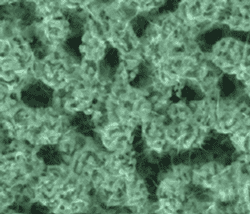 Miniaturization of microelectromechanical systems (MEMS) and electronic devices has fueled the need for highly efficient, reliable and small power sources that can be produced on an industrial scale. Using existing MEMs processing techniques, researchers at the WPI Advanced Institute for Materials Research, Tohoku University, Japan have developed a micro-sized psuedocapacitor (MPC) with excellent energy and power density. Since these devices are fabricated using MEMs processes, they will integrate readily with existing electronic circuit technology, and are suitable for use as stable on-chip micro power supplies
Miniaturization of microelectromechanical systems (MEMS) and electronic devices has fueled the need for highly efficient, reliable and small power sources that can be produced on an industrial scale. Using existing MEMs processing techniques, researchers at the WPI Advanced Institute for Materials Research, Tohoku University, Japan have developed a micro-sized psuedocapacitor (MPC) with excellent energy and power density. Since these devices are fabricated using MEMs processes, they will integrate readily with existing electronic circuit technology, and are suitable for use as stable on-chip micro power supplies
The microcapacitors are constructed of two interlocking eight-pin electrodes, formed of hierarchically nanoporous gold, plated with manganese oxide, and immersed in electrolyte. The devices have been tested in different electrolytes— aqueous LiC, a solid, PVA-LiC hydrogel-polymer, and an ionic liquid-based ionogel—with excellent performance in each case, compared to existing, carbon/graphene-based micro-supercapacitors MSC. For each case, the devices showed much higher capacitance than the corresponding carbon based MSC.In addition, the MPC devices also show very pure capacitive behavior, with little resistance, as well as a very fast time constant, and stable capacitance over 1500 cycles. For the ionogel-filled MPC, although the capacitance is reduced compared to the aqueous-electrolyte-filled MPCs, the energy density is much higher, due to a greatly increased operating voltage. This energy density is even higher than commercially available Li thin film batteries; while the MPCs with all electrolytes also have power density of approximately three orders of magnitude higher than the Li thin film batteries
The nanoporous gold framework of the electrodes is constructed through a two-step dealloying of an electrochemically plated Au17.7Ag82.3 (at%) precursor, producing a highly porous, flaw free gold structure. The hierarchical structure contains nanopores of two sizes, 200–300 nm, and 20–40 nm. During plating with MnO2, the porous structure allows excellent penetration of the MnO2 throughout the electrode, leading to good deposition of MnO2 across the whole surface area of the electrode. The pores remain open even after plating, allowing for a high contact surface area between the active MnO2 and the electrolyte. The psuedocapacitors store energy by means of a reversible redox reaction on the surface of the MnO2, and a linear relationship is found between the MnO2 deposition time, and the areal capacitance of the device. The porous structure enhances the reaction on the surface of the MnO2 byproviding easy ion transport routes through the structure.
For practical applications, the MPCs can be joined in series or in parallel to deliver the required operational voltage or lifetime, as has been demonstrated by the authors in the use of three of the MPCs to power an LED. Since the fabrication methods are the same as those used in the fabrication of MEMs devices, these MPCs are directly compatible, and can be used as power supplies for MEMs devices, as well as on-chip power supplies for integrated electronic circuits.
Advanced Science is a new journal from the team behind Advanced Materials, Advanced Functional Materials, and Small. The journal is fully Open Access and is free to read now at www.advancedscience.com.

















